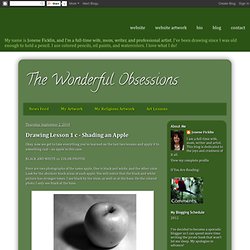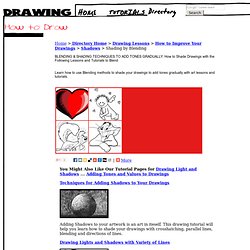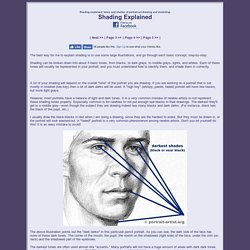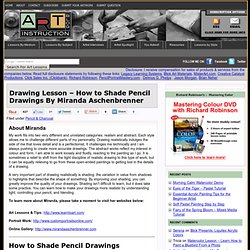

Basic Pencil Shading by Snigom on deviantART. Drawing Lesson 1 c - Shading an Apple. Okay, now we get to take everything you’ve learned on the last two lessons and apply it to something real – an apple in this case.

BLACK AND WHITE vs. COLOR PHOTOS Here are two photographs of the same apple. One is black and white, and the other color. Look for the absolute black areas of each apple. Black and white drawings are more dramatic, just like the photo. Look at the color photo, near the bottom of the apple and a little to the right. Now look at the photos and concentrate on the highlights. So the rest of the apple has a tone of 3 or darker. You’ll notice some funny things going on in the shaded area on the left.
Okay, now that you can see all those things, we’re ready to start. TIP: if you are using fine pencils, use your 2H for basic sketching - you can switch to your other pencils as needed once you get into your shading. If you are using a standard number 2 pencil, draw very lightly. Now, draw an outline of an apple. Drawing lesson for Beginner artists: Proportions of the face, front view - Step 1 : Model. Shading by Blending Drawing Lessons & How to Draw Shadows & Shade & Blend Tones Gradually with Art Tutorials for Illustrations, Comics, Cartoons. You Might Also Like Our Tutorial Pages for Drawing Light and Shadows ...

Shading explained: Portrait Art Basics - lessons on drawing the face. The best way for me to explain shading is to use some large illustrations, and go through each basic concept, step-by-step.

Shading can be broken down into about 5 basic tones, from blacks, to dark grays, to middle grays, lights, and whites. Each of these tones will usually be represented in your portrait, and you must understand how to identify them, and shade them in correctly. A lot of your shading will depend on the overall "tone" of the portrait you are drawing. If you are working on a portrait that is set mostly in shadow (low key) then a lot of dark darks will be used. A "high key" (whispy, pastel, faded) portrait will have few blacks, but more light grays. However, most portraits have a balance of light and dark tones. I usually draw the black-blacks in last when I am doing a drawing, since they are the hardest to erase. The above illustration points out the "dark darks" in this particular pencil portrait. The darkest tones are often used almost like "accents. " Next >> How to Draw 3D Shapes with Shading.
Home » How to Draw 3D Shapes » with Shading In this lesson we will cover how you can draw 3D shapes with shading.

It is all about pressing the pencil down on the paper with different strength, so that the color is stronger or lighter. If you spread these different values correctly, you get an awesome 3D effect. Shading Techniques With Pencil. Once you have mastered the basic pencil drawing techniques from the last tutorial, these can then be used to create different shading techniques within pencil drawings.

This tutorial will guide you through the process of creating different shades and a shading guide in which you will be able to refer to throughout this tutorial. A shading guide when learning to draw is a useful tool to have, as you will be able to assess which shade is appropriate for different parts of the pencil portrait before executing it. In time, as you become more familiar with the different shades you can create, you will be able to ditch the shading guide and execute shading as though it is completely natural to you.
When you were back at the process of choosing your art supplies, you would have made a decision on whether to purchase a set of drawing pencils in different grades, or just one single pencil in a versatile grade. Again, this is a personal preference, and different people prefer different things. 1.) .) Drawing Lesson - How to Shade Pencil Drawings By Miranda Aschenbrenner. About Miranda My work fits into two very different and unrelated categories: realism and abstract.

Each style allows me to challenge different parts of my personality. Drawing realistically indulges the side of me that loves detail and is a perfectionist. It challenges me technically and I am always pushing to create more accurate drawings. The abstract works reflect my interest in colour and form. A very important part of drawing realistically is shading: the variation in value from shadows to highlights that describe the shape of something.
To learn more about Miranda, please take a moment to visit her websites below: Art Lessons & Tips: